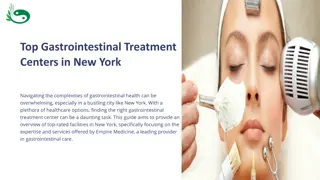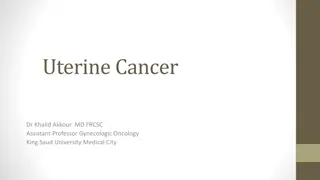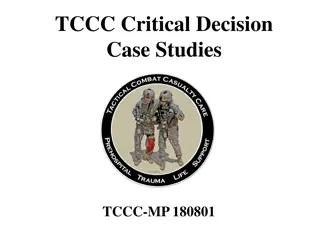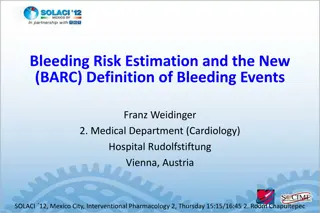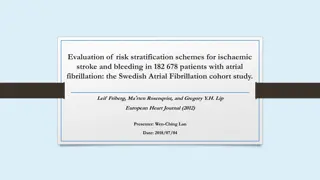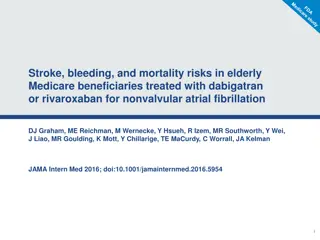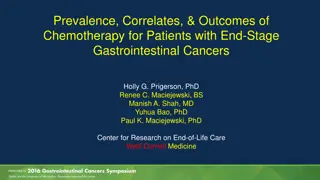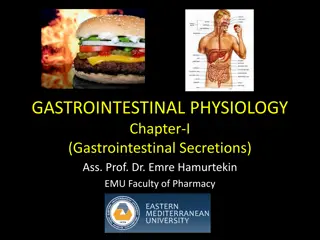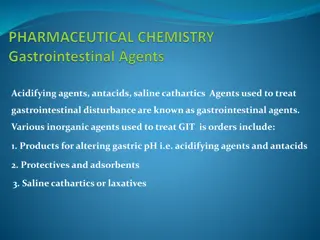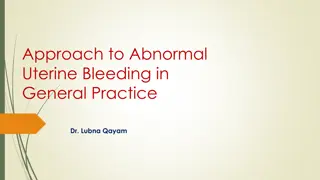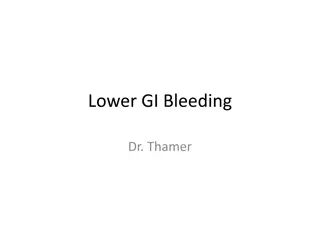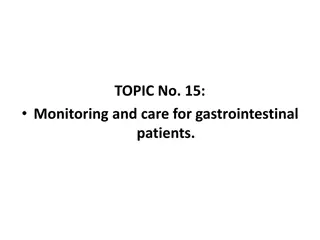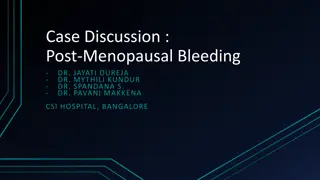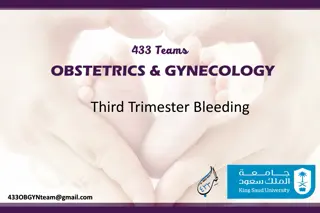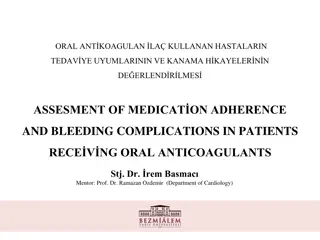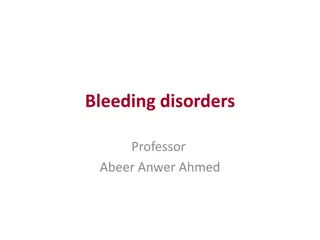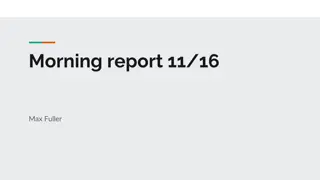Lower Gastrointestinal Bleeding
Lower gastrointestinal bleeding (LGIB) is bleeding in the GI tract distal to the ligament of Treitz. It commonly presents as hematochezia, melena, or occult bleeding. The causes include hemorrhoids, diverticulosis, AV malformations, polyps, IBD, and more. Hemorrhoids, a common source of LGIB, are dilated veins in the rectum or anus. Treatment ranges from reassurance to hemorrhoidectomy depending on severity.
Download Presentation

Please find below an Image/Link to download the presentation.
The content on the website is provided AS IS for your information and personal use only. It may not be sold, licensed, or shared on other websites without obtaining consent from the author.If you encounter any issues during the download, it is possible that the publisher has removed the file from their server.
You are allowed to download the files provided on this website for personal or commercial use, subject to the condition that they are used lawfully. All files are the property of their respective owners.
The content on the website is provided AS IS for your information and personal use only. It may not be sold, licensed, or shared on other websites without obtaining consent from the author.
E N D
Presentation Transcript
Lower Gastrointestinal Bleeding Dr. Nadia farhat ezzawi Gastroenterology department BMC
Definition Lower GIT bleeding is defined as any bleeding in the GI tract distal to ligament of treitz. Majority of the bleeding is self limiting. 90% of the cases colon is the source of bleeding Most common cause of significant LGI bleeding is diverticular disease.
Presentation of lower GIT bleeding Hematochezia:- Passage of fresh blood through the anus, usually in or with the stool. Melena :- Dark sticky feces containing partly digested blood Occult lower GIT bleeding :- anemia.
Aetiology 1- Hemorrhoids . 2- Diverticulosis. 3- AV-malformation 4- Polyps. 5- IBD. 6- Infectious gastroenteritis . 7- Meckels diverticulum. 8- radiation colitis. 9 upper source.
Haemorrhoids Dilated or enlarged veins in the lower portion of the rectum or anus. Causes :- Straining and constipation. Pregnancy. Obesity. Prolonged sitting. Portal hypertension and anorectal varices. Chronic diarrhea Familial.
They are commonly seen in left lateral , right anterior and poeterior (3,7,11 o clock) position with patient in lithotomy position.
Haemorrhoids Haemorrhoids 1stdegree: never prolapse. -2nddegree: prolapse during defecation but return spontaneously -3rddegree: remain prolapsed but can be reduced digitally. -4thdegree: long standing prolapse cannot be reduced
symptoms Rectal bleeding. Bright red blood in stool. Anal pain and itching. Rectal prolapse. Thrombosis may result from defecatory straining .
Treatment Vareis from simple reassurance to operative hemorrhoidectomy. Complicated haemorrhoids cuase sever bleeding and anemia. Stabilization of the patient should be performed before surgery. Fluids , blood transfusion, antibiotics. surgery
diverticulitis Diverticulosis is a condition in which there are small pouches or pockets in the wall or lining of any portion of the digestive tract. inflammation or infection of diverticulae called (Diverticulitis).
Risk factors Rare < 40 yrs Chronic lack of dietary fiber or genetic. obesity. smoking. family history. and NSAID use.
Clinical Features asymptomatic and are only found incidentally during routine colonoscopy or CT imaging. intermittent lower abdominal pain , colicky in nature. Rectal bleeding.. management Patients with diverticular bleeds can often be managed conservatively as most cases will be self- limiting, Any significant bleeding will need appropriate resuscitation, including the use of blood products, and stabilisation.
Endoscopic therapy: Diathermy/laser phtocoagulation. Vasoconstrictive agents (control bleeding). Surgical intervention* is required in those with perforation with faecal peritonitis or overwhelming sepsis.
Angiodysplasia Submucosal vascular malformation. It is caused by arteriovenous malformations between previously healthy blood vessels, most commonly in the caecum and ascending colon.
Angiodysplasia can be divided into acquired or congenital: Acquired angiodysplasia begins as reduced submucosal venous drainage in the colon due to chronic and intermittent contraction of the colon, giving rise to dilated and tortuous veins. This results in the loss of pre-capillary sphincter competency and in turn causes the formation of small arterio-venous communications characterized by a small tuft of dilated vessels. Congenital angiodysplasia such as hereditary haemorrhagic telangectasia (/Rendu-Osler-Weber syndrome) or Heyde s syndrome.
Clinical Features Asymptomatic only diagnosed incidentally during colonoscopy (around 10% cases) Painless occult PR bleeding (majority of case) Acute haemorrhage (10-15% of cases) lower GI lesions (more common in angiodysplasia) are more likely to present as haematochezia. Signs on examination are usually minimal.
investigations Colonoscopy depending on the suspected site of bleeding. Small bowel bleeds : wireless capsule endoscopy may help detection of site of dysplasia. in the setting of an overt angiodysplastic bleed, mesenteric angiography is recommended
Neoplasia of LGI tract It may present as polyp , ulcer or mass. Sloughing off of the lesion may present as lower GI bleeding. Proper evaluation , investigation , biopsy , staging of the neoplasia is to be done for management.
Colitis Infective / inflammatory colitis present as LGI bleeding , mostly hematochezia, pus may also present. IBD usually confirmed by biopsies on colonoscopy. Infectious colitis; in addition to colonoscopy ; stool testing for C.difficile toxins is fequently the first line diagnostic approach.
Approuch to patient with Lower GIT Bleeding History and examination:- a prior history of peptic ulcer disease, diverticulosis, aortic vascular surgery, radiation therapy, use of medications such as non-steroidal anti-inflammatory and anti-coagulants, or recent endoscopy with biopsy may indicate the origin of bleeding. Diagnostic and resuscitative manuevers must occur simultaneously if hemodynamic instability is present. Digital rectal examination with stool guaiac is a routine part of the physical examination
Insert NGT to R/O upper source of bleeding . complete blood count: - type of anemia and cross match, platelet count coagulation parameters. LFTs, albumin, BUN and creatinine. Uss abdomin. Sigmoidoscopy/anoscopy to rule out anorectal sources of hemorrhage. Colonoscopy permits examination of the entire colon and potential therapeutic interventions in LGIB.
When colonoscopy is non diagnostic ; selective angiography is indicated. Consult general surgeon if the cause is surgical (hemorrhoids, fissure , mickles diverticulum) , or the patient continues to actively bleed
summary mortality rates for lower gastrointestinal bleedings are less than 5%. screening anoscopy/sigmoidoscopy After resuscitation is indicated to rule out the presence of anorectal pathology. Unclear diagnosis with active bleeding needs surgical intervention.



